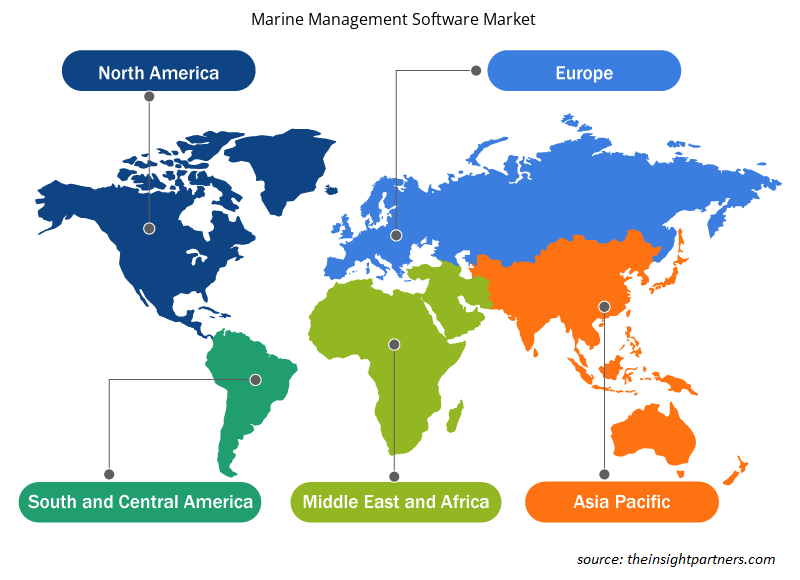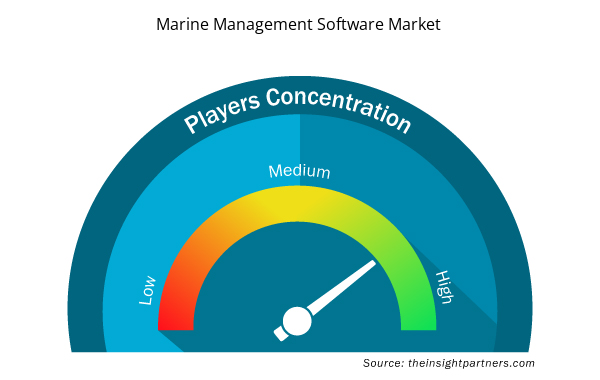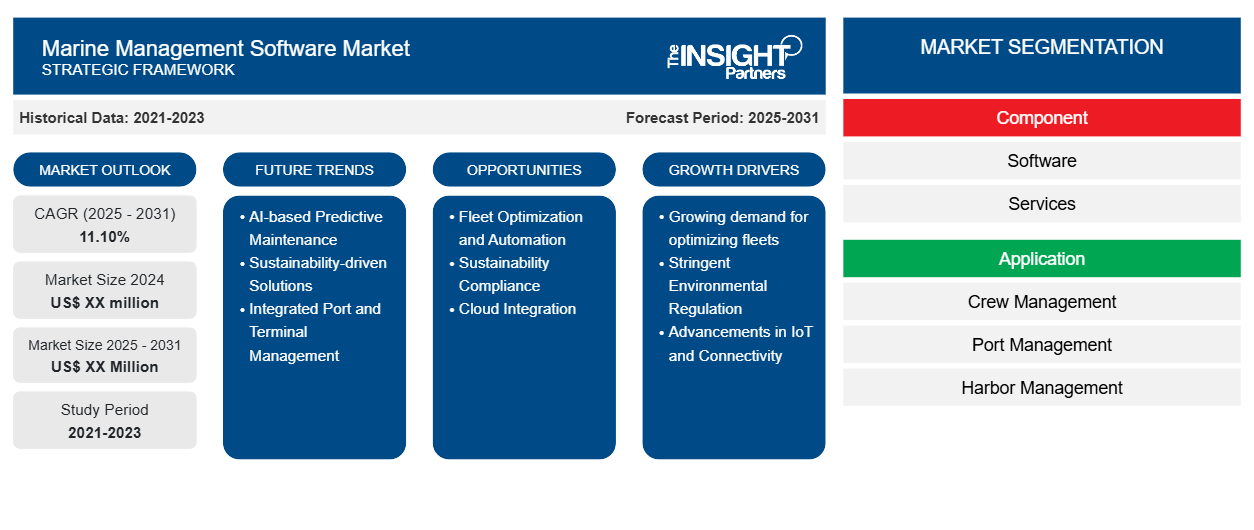Se espera que el mercado de software de gestión marina registre una CAGR del 11,10 % entre 2024 y 2031, con un tamaño de mercado que se expandirá de US$ XX millones en 2024 a US$ XX millones en 2031.
El informe de mercado de software de gestión marina cubre un análisis profundo basado en componentes (software, servicios); aplicaciones (gestión de tripulaciones, gestión de puertos, gestión de reservas, gestión de cruceros y yates); y usuarios finales (comerciales, defensa). El análisis global se desglosa aún más a nivel regional y por países principales.
Propósito del Informe
El informe sobre el mercado de software de gestión marina de The Insight Partners tiene como objetivo describir el panorama actual y el crecimiento futuro, los principales factores impulsores, los desafíos y las oportunidades. Esto proporcionará información a diversas partes interesadas del negocio, como:
- Proveedores/fabricantes de tecnología: Para comprender la dinámica cambiante del mercado y conocer las oportunidades potenciales de crecimiento, lo que les permitirá tomar decisiones estratégicas informadas.
- Inversionistas: Realizar un análisis exhaustivo de tendencias sobre la tasa de crecimiento del mercado, las proyecciones financieras del mercado y las oportunidades que existen en toda la cadena de valor.
- Órganos reguladores: Regular las políticas y vigilar las actividades del mercado con el objetivo de minimizar los abusos, preservar la confianza de los inversores y defender la integridad y estabilidad del mercado.
Segmentación del mercado de software de gestión marina
Componente
- Software
- Servicios
Solicitud
- Gestión de la tripulación
- Gestión portuaria
- Gestión del puerto
- Gestión de reservas
- Gestión de cruceros y yates
Usuario final
- Comercial
- Defensa
Geografía
- América del norte
- Europa
- Asia-Pacífico
- América del Sur y Central
- Oriente Medio y África
Personalice este informe según sus necesidades
Obtendrá personalización en cualquier informe, sin cargo, incluidas partes de este informe o análisis a nivel de país, paquete de datos de Excel, así como también grandes ofertas y descuentos para empresas emergentes y universidades.
- Obtenga las principales tendencias clave del mercado de este informe.Esta muestra GRATUITA incluirá análisis de datos, desde tendencias del mercado hasta estimaciones y pronósticos.
Factores impulsores del crecimiento del mercado del software de gestión marina
- Demanda creciente de optimización de flotas: La necesidad de optimizar el uso de combustible y reducir los costos para las compañías navieras obliga a los software de gestión marítima a proporcionar monitoreo de flotas, optimización de rutas y programación de mantenimiento en tiempo real. Esto permite a los operadores de flotas consumir menos combustible, producir menos emisiones y reducir los gastos generales de las flotas. Por lo tanto, el software mencionado anteriormente es sumamente indispensable para agilizar la gestión eficaz de las flotas.
- Normativa medioambiental estricta: la mayoría de las leyes medioambientales se han promulgado, por ejemplo, la Organización Marítima Internacional 2020, y se han aplicado medidas de control de las emisiones de carbono. Por lo tanto, existe la necesidad de soluciones que cumplan con las normas. El software de gestión marítima permitirá a las empresas rastrear las emisiones, cumplir con las normas medioambientales e incluso presentar informes que puedan utilizarse en las presentaciones ante los organismos reguladores, lo que ha creado una demanda en este campo.
- Avances en IoT y conectividad: el motor de crecimiento detrás de esto es la incorporación de IoT y tecnologías de comunicación basadas en satélites en las operaciones marítimas. Estas combinan una mejor recopilación de datos, rendimiento de los buques, estado del equipo y protocolos de seguridad monitoreados de forma remota. Es a través de esta conectividad que el software de gestión marina permite obtener información en tiempo real sobre la mejora de la misma para mejorar aún más la toma de decisiones y la eficiencia operativa con la que otros factores impulsarán el crecimiento del mercado.
Tendencias futuras del mercado de software de gestión marina
- Mantenimiento predictivo basado en IA: las empresas de software de gestión marina recurren cada vez más a algoritmos de aprendizaje automático e inteligencia artificial para predecir fallas en los equipos incluso antes de que ocurran, lo que permite minimizar el tiempo de inactividad y optimizar el rendimiento de la flota con datos en tiempo real de sensores y maquinaria. Como resultado, los costos finales se han reducido y la vida útil de los activos se ha extendido.
- Soluciones orientadas a la sostenibilidad: La legislación medioambiental ha llevado a la industria hacia una actividad más ecológica. El seguimiento de la huella de carbono, la optimización del combustible y el control de las emisiones fueron funciones incluidas en el software de gestión marina para poder cumplir con los parámetros de sostenibilidad globales. Estas resultaron ser herramientas que reducen el consumo de combustible, reducen las emisiones y cumplen con la estricta legislación medioambiental.
- Gestión integrada de puertos y terminales: Los sistemas de gestión integrada de puertos y terminales han sido impulsados por la creciente demanda de operaciones logísticas y de cadena de suministro eficientes. Minimizan los retrasos debidos a la ineficiencia en el manejo de la carga, la mala asignación de atracaderos y la programación de los buques, mejorando así la eficiencia general. En este mundo de transporte marítimo global de gran volumen, la gestión eficiente de los puertos se considera la columna vertebral de las organizaciones exitosas.
Oportunidades de mercado en el software de gestión marina
- Optimización y automatización de flotas: con una mayor demanda de aplicaciones que puedan ayudar a aumentar la eficiencia de la flota y automatizar las operaciones marinas.
- Cumplimiento de sostenibilidad: Cumplimiento de sostenibilidad, ofreciendo soluciones relacionadas con un recorte ambientalmente seguro para las empresas marinas en la búsqueda de sus derechos en términos de cumplir con las regulaciones establecidas por el gobierno y reducir las emisiones.
- Integración en la nube: esto requeriría una demanda creciente de software de gestión marina basado en la nube que se utilizaría para el monitoreo en tiempo real y la operación remota, entre otros.
Perspectivas regionales del mercado de software de gestión marina
Los analistas de Insight Partners explicaron en detalle las tendencias y los factores regionales que influyen en el mercado de software de gestión marina durante el período de pronóstico. Esta sección también analiza los segmentos y la geografía del mercado de software de gestión marina en América del Norte, Europa, Asia Pacífico, Oriente Medio y África, y América del Sur y Central.

- Obtenga datos regionales específicos para el mercado de software de gestión marina
Alcance del informe de mercado de software de gestión marina
| Atributo del informe | Detalles |
|---|---|
| Tamaño del mercado en 2024 | XX millones de dólares estadounidenses |
| Tamaño del mercado en 2031 | US$ XX millones |
| CAGR global (2024 - 2031) | 11,10% |
| Datos históricos | 2021-2023 |
| Período de pronóstico | 2025-2031 |
| Segmentos cubiertos | Por componente
|
| Regiones y países cubiertos | América del norte
|
| Líderes del mercado y perfiles de empresas clave |
|
Densidad de actores del mercado de software de gestión marina: comprensión de su impacto en la dinámica empresarial
El mercado de software de gestión marina está creciendo rápidamente, impulsado por la creciente demanda de los usuarios finales debido a factores como la evolución de las preferencias de los consumidores, los avances tecnológicos y una mayor conciencia de los beneficios del producto. A medida que aumenta la demanda, las empresas amplían sus ofertas, innovan para satisfacer las necesidades de los consumidores y aprovechan las tendencias emergentes, lo que impulsa aún más el crecimiento del mercado.
La densidad de actores del mercado se refiere a la distribución de las empresas o firmas que operan dentro de un mercado o industria en particular. Indica cuántos competidores (actores del mercado) están presentes en un espacio de mercado determinado en relación con su tamaño o valor total de mercado.
Las principales empresas que operan en el mercado de software de gestión marina son:
- Oráculo
- TEJIDO
- Soluciones marinas MariApps Pte Ltd
- Grupo ABS
- DNV GL
Descargo de responsabilidad : Las empresas enumeradas anteriormente no están clasificadas en ningún orden particular.

- Obtenga una descripción general de los principales actores clave del mercado de software de gestión marina
Puntos de venta clave
- Cobertura integral: el informe cubre de manera integral el análisis de productos, servicios, tipos y usuarios finales del mercado de software de gestión marina, proporcionando un panorama holístico.
- Análisis de expertos: el informe se compila sobre la base de un profundo conocimiento de expertos y analistas de la industria.
- Información actualizada: El informe asegura relevancia comercial debido a su cobertura de información reciente y tendencias de datos.
- Opciones de personalización: este informe se puede personalizar para satisfacer los requisitos específicos del cliente y adaptarse adecuadamente a las estrategias comerciales.
Por lo tanto, el informe de investigación sobre el mercado de software de gestión marina puede ayudar a abrir camino para descifrar y comprender el escenario de la industria y las perspectivas de crecimiento. Si bien puede haber algunas preocupaciones válidas, los beneficios generales de este informe tienden a superar las desventajas.
- Análisis histórico (2 años), año base, pronóstico (7 años) con CAGR
- Análisis PEST y FODA
- Tamaño del mercado Valor/volumen: global, regional, nacional
- Industria y panorama competitivo
- Conjunto de datos de Excel



Report Coverage
Revenue forecast, Company Analysis, Industry landscape, Growth factors, and Trends

Segment Covered
This text is related
to segments covered.

Regional Scope
North America, Europe, Asia Pacific, Middle East & Africa, South & Central America

Country Scope
This text is related
to country scope.
Preguntas frecuentes
Some of the customization options available based on request are additional 3-5 company profiles and country-specific analysis of 3-5 countries of your choice. Customizations are to be requested/discussed before making final order confirmation, as our team would review the same and check the feasibility.
The report can be delivered in PDF/PPT format; we can also share excel dataset based on the request.
Key companies in this market are: Oracle, ABB, MariApps Marine Solutions, Pte Ltd, ABS Group, DNV GL, Kongsberg Maritime, Matrid Technologies, Tero Marine AS, Veson Nautical
The Marine management software market is expected to register a CAGR of 11.10% from 2023-2031.
Key future trends in this market are - AI predictive maintenance for marine fleet performance, sustainability-driven marine software for emission monitoring, integrated port and terminal management systems for logistics.
The major driving forces in the Marine management software market are - fleet optimization, Regulatory Compliance, and Operational Cost.
Trends and growth analysis reports related to Technology, Media and Telecommunications : READ MORE..
1.Oracle
2.ABB
3.MariApps Marine Solutions Pte Ltd
4.ABS Group
5.DNV GL
6.Kongsberg Maritime
7.Matrid Technologies
8.Tero Marine AS
9.Veson Nautical
10.Dockwa
The Insight Partners performs research in 4 major stages: Data Collection & Secondary Research, Primary Research, Data Analysis and Data Triangulation & Final Review.
- Data Collection and Secondary Research:
As a market research and consulting firm operating from a decade, we have published and advised several client across the globe. First step for any study will start with an assessment of currently available data and insights from existing reports. Further, historical and current market information is collected from Investor Presentations, Annual Reports, SEC Filings, etc., and other information related to company’s performance and market positioning are gathered from Paid Databases (Factiva, Hoovers, and Reuters) and various other publications available in public domain.
Several associations trade associates, technical forums, institutes, societies and organization are accessed to gain technical as well as market related insights through their publications such as research papers, blogs and press releases related to the studies are referred to get cues about the market. Further, white papers, journals, magazines, and other news articles published in last 3 years are scrutinized and analyzed to understand the current market trends.
- Primary Research:
The primarily interview analysis comprise of data obtained from industry participants interview and answers to survey questions gathered by in-house primary team.
For primary research, interviews are conducted with industry experts/CEOs/Marketing Managers/VPs/Subject Matter Experts from both demand and supply side to get a 360-degree view of the market. The primary team conducts several interviews based on the complexity of the markets to understand the various market trends and dynamics which makes research more credible and precise.
A typical research interview fulfils the following functions:
- Provides first-hand information on the market size, market trends, growth trends, competitive landscape, and outlook
- Validates and strengthens in-house secondary research findings
- Develops the analysis team’s expertise and market understanding
Primary research involves email interactions and telephone interviews for each market, category, segment, and sub-segment across geographies. The participants who typically take part in such a process include, but are not limited to:
- Industry participants: VPs, business development managers, market intelligence managers and national sales managers
- Outside experts: Valuation experts, research analysts and key opinion leaders specializing in the electronics and semiconductor industry.
Below is the breakup of our primary respondents by company, designation, and region:

Once we receive the confirmation from primary research sources or primary respondents, we finalize the base year market estimation and forecast the data as per the macroeconomic and microeconomic factors assessed during data collection.
- Data Analysis:
Once data is validated through both secondary as well as primary respondents, we finalize the market estimations by hypothesis formulation and factor analysis at regional and country level.
- Macro-Economic Factor Analysis:
We analyse macroeconomic indicators such the gross domestic product (GDP), increase in the demand for goods and services across industries, technological advancement, regional economic growth, governmental policies, the influence of COVID-19, PEST analysis, and other aspects. This analysis aids in setting benchmarks for various nations/regions and approximating market splits. Additionally, the general trend of the aforementioned components aid in determining the market's development possibilities.
- Country Level Data:
Various factors that are especially aligned to the country are taken into account to determine the market size for a certain area and country, including the presence of vendors, such as headquarters and offices, the country's GDP, demand patterns, and industry growth. To comprehend the market dynamics for the nation, a number of growth variables, inhibitors, application areas, and current market trends are researched. The aforementioned elements aid in determining the country's overall market's growth potential.
- Company Profile:
The “Table of Contents” is formulated by listing and analyzing more than 25 - 30 companies operating in the market ecosystem across geographies. However, we profile only 10 companies as a standard practice in our syndicate reports. These 10 companies comprise leading, emerging, and regional players. Nonetheless, our analysis is not restricted to the 10 listed companies, we also analyze other companies present in the market to develop a holistic view and understand the prevailing trends. The “Company Profiles” section in the report covers key facts, business description, products & services, financial information, SWOT analysis, and key developments. The financial information presented is extracted from the annual reports and official documents of the publicly listed companies. Upon collecting the information for the sections of respective companies, we verify them via various primary sources and then compile the data in respective company profiles. The company level information helps us in deriving the base number as well as in forecasting the market size.
- Developing Base Number:
Aggregation of sales statistics (2020-2022) and macro-economic factor, and other secondary and primary research insights are utilized to arrive at base number and related market shares for 2022. The data gaps are identified in this step and relevant market data is analyzed, collected from paid primary interviews or databases. On finalizing the base year market size, forecasts are developed on the basis of macro-economic, industry and market growth factors and company level analysis.
- Data Triangulation and Final Review:
The market findings and base year market size calculations are validated from supply as well as demand side. Demand side validations are based on macro-economic factor analysis and benchmarks for respective regions and countries. In case of supply side validations, revenues of major companies are estimated (in case not available) based on industry benchmark, approximate number of employees, product portfolio, and primary interviews revenues are gathered. Further revenue from target product/service segment is assessed to avoid overshooting of market statistics. In case of heavy deviations between supply and demand side values, all thes steps are repeated to achieve synchronization.
We follow an iterative model, wherein we share our research findings with Subject Matter Experts (SME’s) and Key Opinion Leaders (KOLs) until consensus view of the market is not formulated – this model negates any drastic deviation in the opinions of experts. Only validated and universally acceptable research findings are quoted in our reports.
We have important check points that we use to validate our research findings – which we call – data triangulation, where we validate the information, we generate from secondary sources with primary interviews and then we re-validate with our internal data bases and Subject matter experts. This comprehensive model enables us to deliver high quality, reliable data in shortest possible time.


 Obtenga una muestra gratuita de este informe
Obtenga una muestra gratuita de este informe